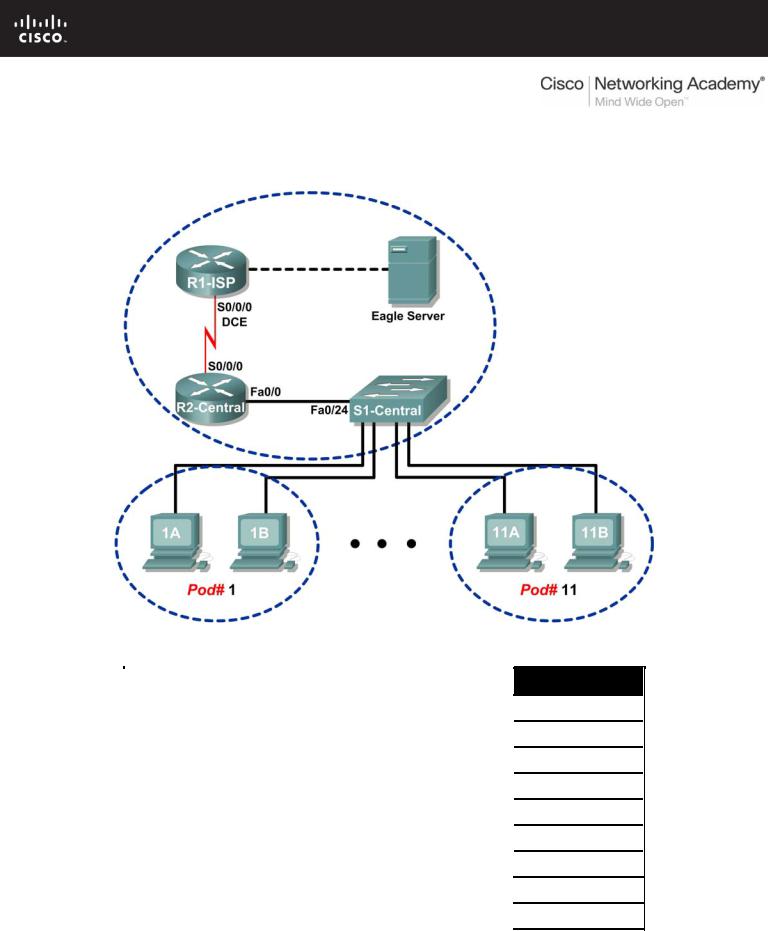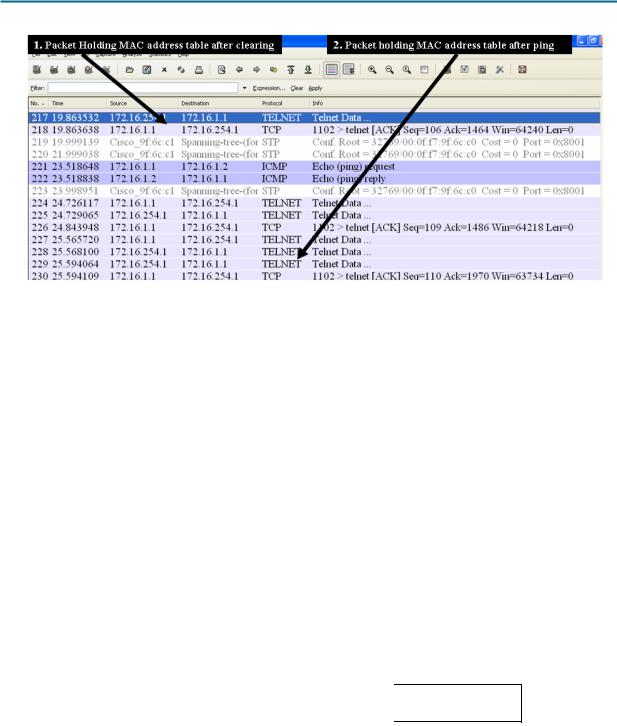
- •Activity 1.1.1: Using Google Earth™ to View the World
- •Activity 1.4.5: Identifying Top Security Vulnerabilities
- •Lab 1.6.1: Using Collaboration Tools— IRC and IM
- •Lab 1.6.2: Using Collaboration Tools—Wikis and Web Logs
- •1.7.1: Skills Integration Challenge-Introduction to Packet Tracer
- •Activity 2.2.5: Using NeoTrace™ to View Internetworks
- •Lab 2.6.1: Topology Orientation and Building a Small Network
- •Lab 2.6.2: Using Wireshark™ to View Protocol Data Units
- •2.7.1: Skills Integration Challenge-Examining Packets
- •Activity 3.4.1: Data Stream Capture
- •Lab 3.4.2: Managing a Web Server
- •Lab 3.4.3: E-mail Services and Protocols
- •Lab 4.5.1: Observing TCP and UDP using Netstat
- •Lab 4.5.2: TCP/IP Transport Layer Protocols, TCP and UDP
- •Lab 4.5.3: Application and Transport Layer Protocols Examination
- •Lab 5.5.1: Examining a Device’s Gateway
- •Lab 5.5.2: Examining a Route
- •5.6.1: Skills Integration Challenge-Routing IP Packets
- •Lab 6.7.1: Ping and Traceroute
- •Lab 6.7.2: Examining ICMP Packets
- •Activity 6.7.3: IPv4 Address Subnetting Part 1
- •Activity 6.7.4: IPv4 Address Subnetting Part 2
- •Lab 6.7.5: Subnet and Router Configuration
- •Lab 7.5.2: Frame Examination
- •7.6.1: Skills Integration Challenge-Data Link Layer Issues
- •Lab 8.4.1: Media Connectors Lab Activity
- •Lab 9.8.1: Address Resolution Protocol (ARP)
- •Lab 9.8.2: Cisco Switch MAC Table Examination
- •Lab 9.8.3: Intermediary Device as an End Device
- •9.9.1: Skills Integration Challenge-Switched Ethernet
- •Lab 10.3.2: How Many Networks?
- •Lab 10.6.1: Creating a Small Lab Topology
- •Lab 10.6.2: Establishing a Console Session with HyperTerminal
- •Lab 10.6.3: Establishing a Console Session with Minicom
- •11.4.3.3: Network Latency Documentation with Ping
- •Lab 11.5.1: Basic Cisco Device Configuration
- •Lab 11.5.2: Managing Device Configuration
- •Lab 11.5.3: Configure Host Computers for IP Networking
- •Lab 11.5.4: Network Testing
- •Lab 11.5.5: Network Documentation with Utility Commands
- •Lab 11.5.6: Final Case Study - Datagram Analysis with Wireshark

Lab 9.8.3: Intermediary Device as an End Device
Topology Diagram
Addressing Table
Device |
Interface |
IP Address |
Subnet Mask |
Default Gateway |
|
|
|
|
|
|
|
R1-ISP |
S0/0/0 |
10.10.10.6 |
255.255.255.252 |
N/A |
|
|
|
|
|
||
Fa0/0 |
192.168.254.253 |
255.255.255.0 |
N/A |
||
|
|||||
|
|
|
|
|
|
R2-Central |
S0/0/0 |
10.10.10.5 |
255.255.255.252 |
10.10.10.6 |
|
|
|
|
|
||
Fa0/0 |
172.16.255.254 |
255.255.0.0 |
N/A |
||
|
|||||
|
|
|
|
|
|
Eagle Server |
N/A |
192.168.254.254 |
255.255.255.0 |
192.168.254.253 |
|
|
|
|
|
||
N/A |
172.31.24.254 |
255.255.255.0 |
N/A |
||
|
|||||
|
|
|
|
|
|
hostPod#A |
N/A |
172.16.Pod#.1 |
255.255.0.0 |
172.16.255.254 |
|
|
|
|
|
|
|
hostPod#B |
N/A |
172.16.Pod#.2 |
255.255.0.0 |
172.16.255.254 |
|
|
|
|
|
|
|
S1-Central |
N/A |
172.16.254.1 |
255.255.0.0 |
172.16.255.254 |
|
|
|
|
|
|
All contents are Copyright © 1992–2007 Cisco Systems, Inc. All rights reserved. This document is Cisco Public Information. Page 1 of 5

CCNA Exploration |
|
Network Fundamentals: Ethernet |
Lab 9.8.3: Intermediary Device as an End Device |
Learning Objectives
Upon completion of this lab, you will be able to:
•Use Wireshark to capture and analyze frames originating from network nodes.
•Examine the origination of frames in a small network.
Background
A switch is used to route frames between network devices. A switch does not normally originate the frame to node devices. Rather, a switch efficiently passes the frame from one device to another in the LAN.
Scenario
Wireshark will be used to capture and analyze Ethernet frames. If Wireshark has not been loaded on the host pod computer, it can be downloaded from URL ftp://eagleserver.example.com/pub/eagle_labs/eagle1/chapter9/, file wireshark-setup- 0.99.4.exe.
In this lab you will ping a neighbor’s pod host computer.
Write down the IP address and port connection on S1-Central for the neighbor’s pod host computer: IP Address: ______________________________________ S1-Central port number: ___________
Task 1: Use Wireshark to Capture and Analyze Frames Originating From Network Nodes.
Step 1: Configure Wireshark for packet captures.
Prepare Wireshark for captures.
1.Click Capture > Options.
2.Select the Interface that corresponds to the LAN.
3.Check the box to Update list of packets in real time.
4.Click Start.
This will begin the packet capture. During this capture there will probably be more than 200 captures, making analysis a bit tedious. The critical Telnet conversation between the pod host computer and S1Central will be easy to filter.
Step 2: Use the Windows Telnet client to access S1-Central.
S1-Central has been configured with 11 student accounts, ccna1 through ccna11. To provide access to each student, use the userid corresponding to your pod. For example, for host computers on pod 1, use userid ccna1. Unless directed otherwise by your instructor, the password is cisco.
1. From the Windows terminal, issue the Telnet command, telnet destination-ip-address:
C:/> telnet 172.16.254.1
2.Enter the appropriate user name and password, cisco. The S1-Central prompt should be returned, S1-Central#.
All contents are Copyright © 1992–2007 Cisco Systems, Inc. All rights reserved. This document is Cisco Public Information. |
Page 2 of 5 |

CCNA Exploration |
|
Network Fundamentals: Ethernet |
Lab 9.8.3: Intermediary Device as an End Device |
Step 3: Clear the MAC address table.
1.Examine the switch MAC address table with the command show mac-address-table. In addition to several static CPU entries, there should be numerous dynamic address table entries.
2.To clear dynamic MAC address table entries, use the clear mac-address-table dynamic command.
3.List the dynamic MAC address entries:
MAC Address |
Switch Port |
|
|
|
|
|
|
4.Open a second terminal window. Ping your neighbor’s IP address, which was recorded earlier:
C:>\ ping –n 1 ip-address
5.The MAC address for this computer should be dynamically added in the S1-Central MAC address table.
6.Again list the dynamic MAC address entries:
MAC Address |
Switch Port |
|
|
|
|
|
|
What conclusion can be made about how a switch learns MAC addresses connected to switch interfaces?
____________________________________________________________________________
____________________________________________________________________________
.
7.Close Wireshark capture.
The capture will be analyzed in the next task.
Task 2: Examine the Origination of Frames in a Small Network.
Step 1: Examine a Telnet session to S1-Central.
1.Highlight one of the Telnet session packets. On Wireshark menu, click Analyze | Follow TCP Stream. A stream content window will open, default display ASCII. If the username and passwords are not visible, switch to HEX Dump.
2.Verify the username and password that you entered:
Username: ___________________________ Password: __________
3.Close the stream content window.
Step 2: Examine output of the show mac-address-table command.
1.Open Notepad. Captured data will be transferred to Notepad for analysis. There may be numerous packets that were captured.
2.In the top Wireshark Packet List pane, scroll down to the captured ICMP request. If the bottom Wireshark Packet Byte window is not visible, click View > Packet bytes.
All contents are Copyright © 1992–2007 Cisco Systems, Inc. All rights reserved. This document is Cisco Public Information. |
Page 3 of 5 |

CCNA Exploration |
|
Network Fundamentals: Ethernet |
Lab 9.8.3: Intermediary Device as an End Device |
Figure 1. Wireshark Capture of Telnet
See Figure 1, a partial output of the Wireshark capture:
 Select the last Telnet data packet from S1-Central before the ping command. Next, select the corresponding Packet byte. Right-click the Packet byte and click Copy > Text only. In Notepad, click Edit > Paste. Dynamic mappings should be similar to the following output:
Select the last Telnet data packet from S1-Central before the ping command. Next, select the corresponding Packet byte. Right-click the Packet byte and click Copy > Text only. In Notepad, click Edit > Paste. Dynamic mappings should be similar to the following output:
{_lEMaNL;RPC Mac Address Table
-------------------------------------------
Vlan |
Mac Address |
Type |
Ports |
|
---- |
----------- |
-------- |
----- |
|
All |
000f.f79f.6cc0 |
STATIC |
CPU |
|
All |
0100.0ccc.cccc |
STATIC |
CPU |
|
All |
0100.0ccc.cccd |
STATIC |
CPU |
|
All |
0100.0cdd.dddd |
STATIC |
CPU |
|
|
1 |
0010.a47b.015f |
DYNAMIC |
Fa0/1 |
Total Mac Addresses for this criterion: 5
S1-Central#
3.Write down the MAC address and Port number displayed in the output. Does the switch port correspond to your pod host computer? __________
MAC Address |
Type |
Port |
|
|
|
Why is your pod host computer mapping still in the MAC address table, despite having been cleared? _____________________________________________________________________
_____________________________________________________________________________
All contents are Copyright © 1992–2007 Cisco Systems, Inc. All rights reserved. This document is Cisco Public Information. |
Page 4 of 5 |

CCNA Exploration |
|
Network Fundamentals: Ethernet |
Lab 9.8.3: Intermediary Device as an End Device |
 Select the last Telnet data packet immediately after the ping reply. Next, select the corresponding Packet byte. Right-click the Packet byte and click Copy > Text only. In Notepad, click Edit > Paste. Text should be similar to the following Paste action:
Select the last Telnet data packet immediately after the ping reply. Next, select the corresponding Packet byte. Right-click the Packet byte and click Copy > Text only. In Notepad, click Edit > Paste. Text should be similar to the following Paste action:
{_lEPaNM;VP Mac Address Table
-------------------------------------------
Vlan |
Mac Address |
Type |
Ports |
|
---- |
----------- |
-------- |
----- |
|
All |
000f.f79f.6cc0 |
STATIC |
CPU |
|
All |
0100.0ccc.cccc |
STATIC |
CPU |
|
All |
0100.0ccc.cccd |
STATIC |
CPU |
|
All |
0100.0cdd.dddd |
STATIC |
CPU |
|
1 |
0010.a47b.015f |
DYNAMIC |
Fa0/1 |
|
|
1 |
0016.76ac.a76a |
DYNAMIC |
Fa0/2 |
Total Mac Addresses for this criterion: 6
S1-Central#
4.Write down the MAC address and Port number for the second dynamic displayed in the output. Does the switch port correspond to your neighbor’s pod host computer? __________
MAC Address |
Type |
Port |
|
|
|
Task 3: Reflection
The Wireshark capture of a Telnet session between a pod host computer and S1-Central was analyzed to show how a switch dynamically learns about nodes directly connected to it.
Task 4: Challenge
Use Wireshark to capture and analyze a Telnet session between the pod host computer and the Cisco switch. Use the Wireshark menu option Analyze > Follow TCP Stream to view the login user ID and password. How secure is the Telnet protocol? What can be done to make communication with Cisco devices more secure?
___________________________________________________________________________________
___________________________________________________________________________________
___________________________________________________________________________________
___________________________________________________________________________________
___________________________________________________________________________________
Task 5: Clean Up
Wireshark was installed on the pod host computer. If Wireshark needs to be uninstalled, click Start > Control Panel. Open Add or Remove Programs. Select Wireshark, and click Remove.
Remove any files created on the pod host computer during the lab.
Unless directed otherwise by the instructor, turn off power to the host computers. Remove anything that was brought into the lab, and leave the room ready for the next class.
All contents are Copyright © 1992–2007 Cisco Systems, Inc. All rights reserved. This document is Cisco Public Information. |
Page 5 of 5 |
